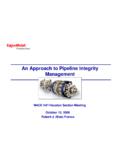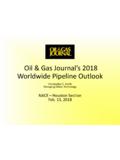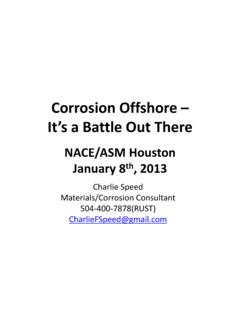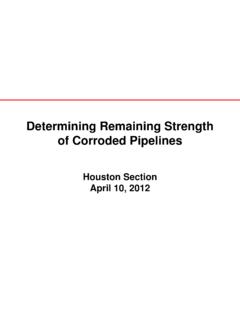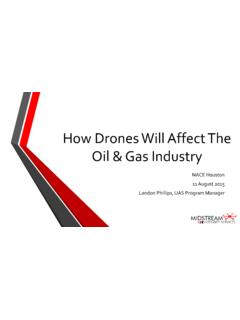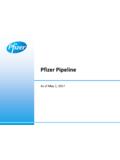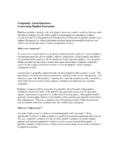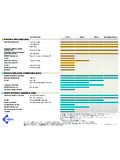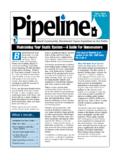Transcription of PIPELINE PIGS - NACE Houston Section
1 PIPELINE pigs . A cleaning pig is any free traveling cleaning device that is sent through a PIPELINE by product flow to scrape and brush foreign deposits, rust and dirt and fluids from the inside surface of the pipe. 500 + types of mechanical pigs . Pig length (inches) = 1 and PIPELINE diameters. PIPELINE pigs may be designed for: purpose, accommodation, economics, endurance, cleaning, flow efficiency improvement, flexibility, heat- resistance, chemical resistance, chemical batching, gauging, mapping, measurements, inspection, and other needs. GENERAL CLEANING RULES. Use the correct type of pig and frequently schedule piggings to maintain PIPELINE integrity and flow efficiency. Select the right pig design to clean the specific hold-up in the PIPELINE . A PIPELINE that can be pigged, should be pigged at least annually to prevent corrosive liquid & solids hold-up.
2 Cleaning or utility pigs , when run on-stream, will have the speed of the pig dictated by the product flow rate. Most gas transmission pipelines flow at ranges between 10 and 17 feet per second. PIG BY-PASS DESIGN. All pigs , regardless of style, are 1% to 5% oversize, and thus are larger than the PIPELINE internal diameter. Most standard pigs are designed to bypass a small portion of the propelling medium during a pig run. By-pass averages between 2% to 15%, depending on the type of pig. Often, pigs may by-pass and leave as much 25% of the product in the pipe after a displacement run. PIG LIFE. Depends on: - Quality of PIPELINE construction - Pig velocity & design - Interior line conditions (rough, semi-rough, smooth). - Media in which pig runs Rules of Thumb: 100 miles (160 km) - for newly constructed onstream gas pipelines 150 miles (240 km) for newly constructed product lines 200 miles (320 km) for newly constructed crude oil lines PIG SPEED.
3 Suggested speed for effective utility pigging: - PIPELINE Pre-commissioning/commissioning = 1-5 MPH ( FPS). - Routine Gas Pigging = 2-8 MPH (3-12 FPS). - Routine Liquid Pigging = 1-8 MPH ( FPS). - ILI Tool Runs = 2-7 MPH (3-10 FPS). REASONS TO PIG. CLEANING, BATCHING, DISPLACEMENT & INSPECTION. 1994 Legislation - Requires new hydrocarbon pipelines to be piggable. - Requires certain existing pipelines to be modified to facilitate pigging. - Requires pipelines to be pigged periodically, if piggable Cleaning - Corrosion control - maintain PIPELINE integrity - Flow efficiency - To dewater lines after hydrostatic testing Monitoring & Inspection - Identify design, manufacturing and construction defects - To gauge or survey the of the pipe - Provide information of developing problems PIG APPLICATIONS.
4 During Construction For Inspection - Removing construction - Check for physical damage debris (geometry). - Acceptance testing - To detect, corrosion, fill/dewater laminations or cracking - Commissioning - Leak detection During Operation - Sampling - Pipe wall cleaning - Line cover and subsea - Condensate removal spanning - Product separation (batching). - Applying inhibitors PIG DESIGNS. Utility pigs for cleaning and sealing - Mandrel pigs - Poly pigs and Foam Swabs - Cast Urethane pigs - Spherical pigs In-Line Inspection Tools (high or low resolution - for wall loss). - Magnaflux Leakage (MFL) Inspection - Ultrasonic Inspection & Geometry Gel pigs - Batching or Separator Gels - Debris Pickup Gels - Hydrocarbon & Dehydration Gels MANDREL pigs . Mandrel pigs are made up of component parts that mount on a steel body allowing multiple configurations and the replacement of individual parts.
5 Individual parts may consist of: cups, magnets, and discs scraping elements, including brushes, or blades for cleaning. Most pig bodies are either aluminum or steel usually with 2 seals, front and rear, made of urethane, nitrile or neoprene. pigs may be uni- or bi-directional during flowing conditions. These pigs are most suited for PIPELINE cleaning and chemical batching. MANDREL PIG BRUSHES. There are four main types of accessory brushes for cleaning pigs : - Block Brushes - Wrap Brushes - Ring Brushes - Pencil Brushes FOAM pigs . Foam or polly pigs are versatile, flexible and usually the least expensive. They are made of open-cell polyurethane foam. They may be uni- or bi-directional in flowing pipelines. The foam may be bare (swab or squeege) or can be coated with urethane for more durability and may contain wire bristle brushes or metal studs for more abrasive cleaning.
6 The density of the foam ranges from 1 lb/cuft to 10 lbs/cuft. SINGLE CAST URETHANE pigs . These single cast urethane pigs are available in sizes from 2 to 48 . They are made of one piece urethane and offer flexibility in performance and capabilities. Pedal (expandable) pigs are used in telescoping (multi-diameter) pipelines. The pigs are used mainly as sealing pigs and for chemical batch treating, but can be equipped with cleaning elements. Some models allow cups, brushes and discs to be changed out when damaged or worn. Most carry pingers, magnets, or other devices. SPHERICAL pigs . Spheres or ball pigs are the oldest and most recognized sealing pigs . Used to push liquids out of pipelines. Three types of spheres: Inflatable, solid, and foam. Suitable for onshore and offshore gathering systems where pigging may be frequent and the system needs to be automated.
7 Suitable for pigging laterals and can drop into downstream mainlines and be swept in by larger pigs . PIG SELECTION AND APPLICATION. Cleaning Applications Sand/Sludge Scale Water Paraffin Bacteria Swabs Fair Poor Fair Poor Poor Pollys Good Fair Good Poor Good Spheres Poor Poor Fair Poor Poor Cast Urethane Good Fair Good Poor Fair Mandrel Urethane Excellent Fair Excellent Fair Fair Bi-Directional Excellent Good Excellent Fair Good Brush pigs Poor Good Poor Poor Excellent Plow Blades Poor Poor Poor Excellent Fair Gel Trains Good Poor Good Poor Fair CHEMICAL BATCH PIGGING. In a dry gas PIPELINE , batch pigging involves running a batch of oil soluble inhibitor or biocide ahead of a single pig; or between two pigs so that the whole internal pipe surface is wetted. In a liquids PIPELINE , batch pigging can be used to separate products by reducing the interface between products.
8 A cleaning pig should be run before batching to clean the pipe surface of contaminants and to prevent dilution of chemicals. Protective inhibitor film (1 mil thick) applied at an optimum pig speed of 5 to 7 feet per second (3 to 5 mph) is shown below using a dual pig train. CHEMICAL BATCH TREATING WITH pigs . Treating Applications Start-Up Inhibitor Biocide Paraffin Solvent Swabs Good Fair Poor Poor Pollys Good Fair Fair Poor Spheres Poor Poor Poor Poor Cast Urethane Good Excellent (a) Excellent (a) Good (b). Mandrel Urethane Good Excellent Excellent Good (b). Bi-Directional Excellent Good Excellent Good (b). Brush pigs Poor Poor Good (c) Poor Plow Blades Poor Poor Poor Fair Gel Trains Good Good (d) Good (d) Fair Notes: (a) Holes can be drilled in the center casting to apply chemical (b) Check solvent/disc or cup material for compatibility (c) Use swab behind brush pig to aid in launch (d) Specialty gels incorporate inhibitors or biocides INTELLIGENT pigs .
9 GEOMETRY pigs . A geometry/caliper pig is a configuration pig that uses mechanical arms or electro-mechanical means to measure the bore of the pipe. It is designed to record conditions in gas and liquid pipelines, such as dents (deformation anamolies), buckles, wrinkles, ovality, bend radius and angle, PIPELINE constrictions, and occasionally indications of significant internal corrosion by making measurements of the inside surface of the pipe. It can sense changes in girth welds and wall thickness at designated locations and is usually run in pipelines before intelligent pigs are run. IN-LINE INSPECTION pigs . A sophisticated in-line inspection tool (pig) run through a segment of PIPELINE to determine areas of defects of both internal and external pipe walls. Provides recordings which indicate the severity and location of the defect.
10 Magna-flux Leakage (MFL): Flux-leakage technology will saturate sections of pipe with a strong magnetic field and the flux path is recorded. Leakage or variations in the flux path, as it travels through the steel pipe are detected by magnetic sensors situated between the magnetic poles, and can be directly related to areas of metal loss. MFL HISTORY. IN-LINE INSPECTION (SMART) pigs . Ultrasonic Technology (UT) uses a transducer to emit a pulse of ultrasonic sound through the pipe which travels at a known speed. On entering the internal pipe wall, there is an echo, and another echo as the pulse reflects off of the external wall. The time taken for these echo's to return provides a virtual direct reading of the wall thickness. Unlike the MFL tools ( pigs ) which have a maximum allowable wall thickness, the UT tools ( pigs ) have a minimum.
